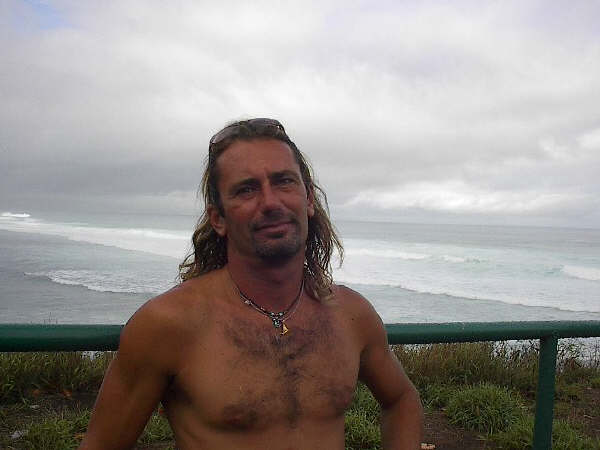Still, three one hour sessions that all ranked around 6 is not a bad day.
This morning's conditions are pictured in the report I already did from Hookipa and they are perfect for a much deserved rest. If you read this blog, you knew since long that there were no expectations to be set for this NW swell because of the proximity of the fetch and the active wind on it.
Knowing the forecast helps mostly two things:
- scoring good sessions
- planning the rest of your activities around good sessions.
Someone might think that's excessive, but in my life surfing is priority one. There's a piece of wooden wall that I cut from one my previous studios (that had to be demolished) that says:"everything revolves around surfing", but that's too long of a story.
Also because, despite the fact that I have more time than usual, I'd to talk about more interesting things.
So let's quickly get rid of today's call.
Buoys readings at
Pauwela
8ft @ 8s from 3° (N)
1.7ft @ 4s from 38° (NE)
1.5ft @ 12s from 339° (NNW)
Lanai
1.9ft @ 14s from 195° (SSW)
which means that the south swell is still here (just saw a shoulder high set on the cam in lahaina).
And that is the only chance for decent surf you have today.
As the MC2km map at noon shows, in fact, there's always a little area that is shadowed enough from the wind on the west side. Most days it will have an onshore breeze starting at around 10am. In particularly windy days like today, I noticed that the onshore gets stronger.
Definitely sailable on the north shore for the wind sport obsessed people (no judgement, I'm a wave obsessed guy), but with stormy, choppy, cold and relatively dangerous (at least at Hookipa) conditions.
Below is the wind map of the north Pacific that shows:
- the high that is generating this round of trade winds. Fortunately it's modeled to move east a bit and that will at least make the direction more easterly (sideoff winds ruin the waves less than sideon winds like today). In summertime, there's a semi permanent high north of Hawaii that generates very consistent trade winds and blocks the storms that generates the ground swells from the northerly quadrants. That's when the blog author gets the hell out of here.
- the low that is generating a swell that will arrive Monday night and that surfline is calling at 6f 14s. I circled the fetch and it looks pretty nice, actually.
And now let me copy and paste a sentence from Oahu master meteorologist Pat Caldwell on his last piece of art (link 9 on the right).
Looking back at the pacioos/cdip american samoa buoy from 3/20-21, the dominant periods were 14-16 seconds. As waves travel, the dominant period increases, which gave the longer periods locally. The longer the period, the greater the amplification when the swell shoals and refracts into breakers.
That is something I always questioned (I question everything by default). I believed the period is something that is related exclusively to the amount of energy that the wind transfers to the ocean surface when it blow over it.
Here's a fact: the stronger the wind, the longer it blows, the winder the area where it blows (that's the fetch), the bigger the waves it generates. If it's a captured fetch that moves in the same direction of the swell it's generating, than the waves grow even bigger because there's still wind pushing on them.
But once the waves leave the fetch, I believed that that was it. Instead, as uncle Pat illuminates us, the more they travel, the more the period grows. And with that, also the speed at which they travel.
By applying a basic energy conservation principle, there is no doubt that that happens at the expense of the height of the open ocean waves.
Imagine you have two balls of dough to make pizzas. Same exact size. One you spread it thin and wide, the other you spread it less, leave it thicker and get a smaller diameter pizza.
But if you put them back into a shape of the ball, there's still the same amount of dough.
Different is the case of two pizzas (yet to be put in the oven!) that are the same exact thickness and different diameter. When you put them back together into a ball shape, the bigger diameter one will generate a bigger ball, right?
That's the case of two swells of the same exact open ocean height but different period: a 2f 18s swell, will generate wave MUCH bigger than a 2f 10s one when they come to the shore and break. That's because the 2f 18s swell the day before was probably a 4f 16s one and the day before that was probably a 6f 14s one and the day that was probably a 8f 12s one and the day before that was probably a 10f 10s one!
Those numbers I used are totally random, I have no idea of how exactly the size and period changes while travelling, but one goes down and the other goes up.
Now, take swell A of 2f 18s and swell B of 10f 10s. IMAGINING (this is just a theoretical example) that I was super lucky with the numbers in the example above and that swell A is what swell B will become after travelling the right amount of time, the legitimate question I hear you guys asking is the following:
are those swells going to generate the same kind of waves once they hit the reef?
The answer is: not even remotely.
Don't forget that longer period waves travel faster, they gain speed during their journey (that's why they're the first ones that reach the shores when a swell starts to hit).
What happens to a wave when it starts feeling the bottom is something that would require more time and graphic illustration, but work time is approaching for me, so I'm gonna try to make it simple.
When a wave start feeling the floor of the ocean, the bottom of the wave slows down while the top keeps travelling at the same original speed. It's like the wave stumbles on an obstacle and falls forward. The sharpest the obstacle (which means the quicker the ocean floor goes from deep to shallow), the harder the wave stumbles. The faster the wave is travelling, the harder it stumbles again.
So long period waves hitting shallow reef with deep ocean in front means... heavy barrels!
Shore period waves hitting slopy sandy bottoms means mushy beach breaks.
Work time is hitting, I have no time to review what I wrote, I hope you guys appreciate the effort anyway.
Long periods rock. (well, that depends on the spot actually...).











2 comments:
Thank you for your morning lesson Mr GP...very enlightening...
I thank you for sharing and for the time and effort you put into this daily blog. appreciated. Mahalo.
Post a Comment